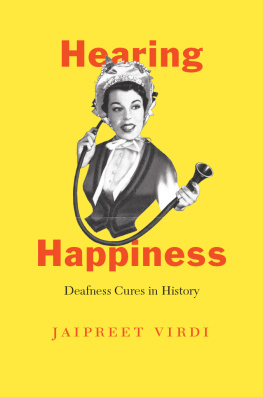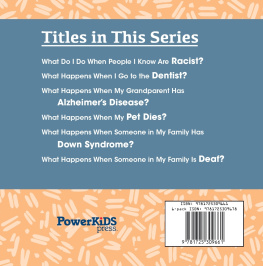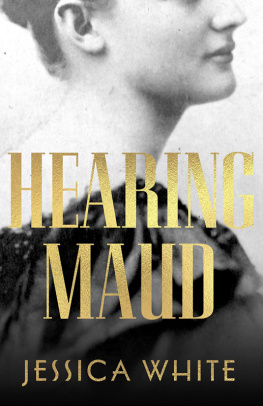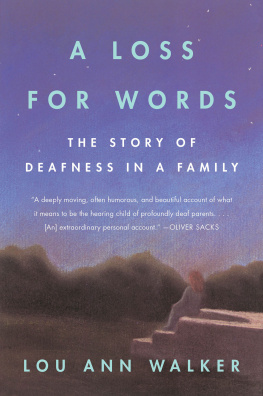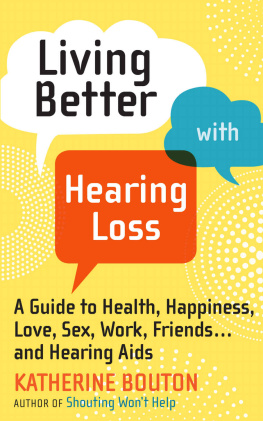Jaipreet Virdi - Hearing Happiness: Deafness Cures in History
Here you can read online Jaipreet Virdi - Hearing Happiness: Deafness Cures in History full text of the book (entire story) in english for free. Download pdf and epub, get meaning, cover and reviews about this ebook. year: 2020, publisher: University of Chicago Press, genre: Home and family. Description of the work, (preface) as well as reviews are available. Best literature library LitArk.com created for fans of good reading and offers a wide selection of genres:
Romance novel
Science fiction
Adventure
Detective
Science
History
Home and family
Prose
Art
Politics
Computer
Non-fiction
Religion
Business
Children
Humor
Choose a favorite category and find really read worthwhile books. Enjoy immersion in the world of imagination, feel the emotions of the characters or learn something new for yourself, make an fascinating discovery.
- Book:Hearing Happiness: Deafness Cures in History
- Author:
- Publisher:University of Chicago Press
- Genre:
- Year:2020
- Rating:4 / 5
- Favourites:Add to favourites
- Your mark:
- 80
- 1
- 2
- 3
- 4
- 5
Hearing Happiness: Deafness Cures in History: summary, description and annotation
We offer to read an annotation, description, summary or preface (depends on what the author of the book "Hearing Happiness: Deafness Cures in History" wrote himself). If you haven't found the necessary information about the book — write in the comments, we will try to find it.
Hearing Happiness: Deafness Cures in History — read online for free the complete book (whole text) full work
Below is the text of the book, divided by pages. System saving the place of the last page read, allows you to conveniently read the book "Hearing Happiness: Deafness Cures in History" online for free, without having to search again every time where you left off. Put a bookmark, and you can go to the page where you finished reading at any time.
Font size:
Interval:
Bookmark:
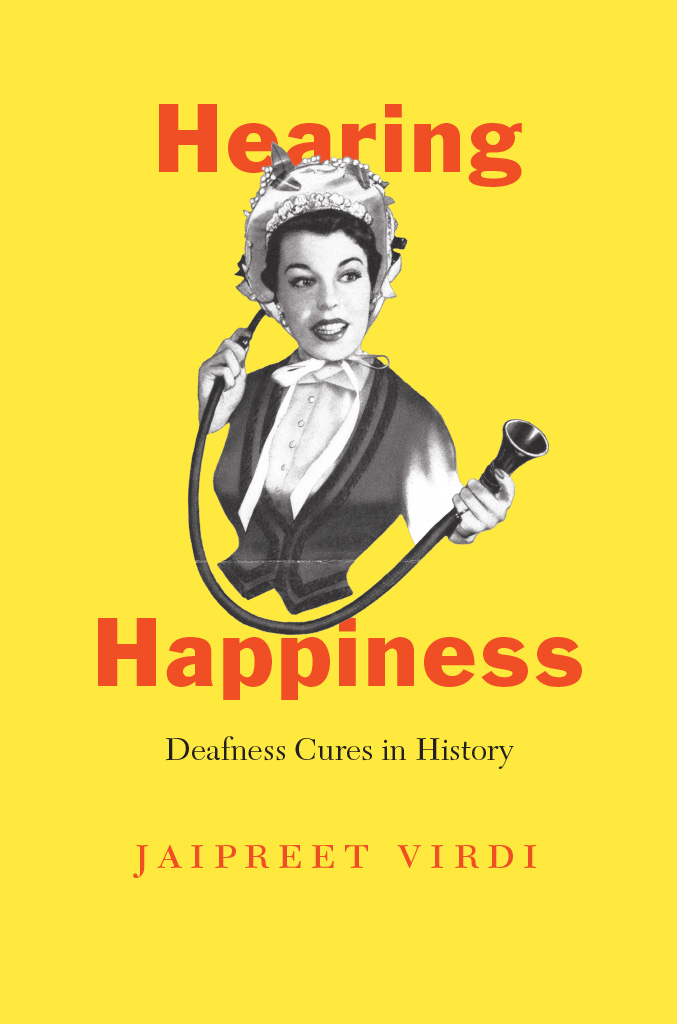
JAIPREET VIRDI
The University of Chicago Press
Chicago and London
The University of Chicago Press, Chicago 60637
The University of Chicago Press, Ltd., London
2020 by The University of Chicago
All rights reserved. No part of this book may be used or reproduced in any manner whatsoever without written permission, except in the case of brief quotations in critical articles and reviews. For more information, contact the University of Chicago Press, 1427 E. 60th St., Chicago, IL 60637.
Published 2020
Printed in the United States of America
29 28 27 26 25 24 23 22 21 20 1 2 3 4 5
ISBN-13: 978-0-226-69061-2 (cloth)
ISBN-13: 978-0-226-69075-9 (e-book)
DOI: https://doi.org/10.7208/chicago/9780226690759.001.0001
Published with support of the Susan E. Abrams Fund.
Library of Congress Cataloging-in-Publication Data
Names: Virdi, Jaipreet, author.
Title: Hearing happiness : deafness cures in history / Jaipreet Virdi.
Description: Chicago ; London : University of Chicago Press, 2020. | Includes bibliographical references and index.
Identifiers: LCCN 2019041405 | ISBN 9780226690612 (cloth) | ISBN 9780226690759 (ebook)
Subjects: LCSH: DeafnessTreatmentUnited StatesHistory19th century. | DeafnessTreatmentUnited StatesHistory20th century. | Quacks and quackeryUnited States. | MedicineUnited StatesHistory.
Classification: LCC RF291 .V57 2020 | DDC 362.4/2dc23
LC record available at https://lccn.loc.gov/2019041405
 This paper meets the requirements of ANSI / NISO Z39.48-1992 (Permanence of Paper).
This paper meets the requirements of ANSI / NISO Z39.48-1992 (Permanence of Paper).
To Geoffrey.
This is yours as much as it is mine.
None of the medicines that are advertised to the public as deafness cure will cure deafness, nor will a good many of the hearing devices that are advertised.
Arthur J. Cramp, Director of the Propaganda Department, American Medical Association, 1929
Acousticon hearing aid advertisement indicating normal living
The technological transformation of acoustic aids
Breathing into the ear to relieve deafness
Astley Coopers procedure for tympanic membrane perforation
Nicolas Deleaus technique for Eustachian tube catherization
F. C. Rein advertisement
Katherine Mansfield with Dorothy Brett and Toby
Self-Portrait by Dorothy Brett
Dorothy Brett with one of her machines
Dorothy Brett with one of her paintings
An elderly woman holding her conversation tube
George H. Wilson, inventor of Wilsons Common Sense Ear Drums
Frances M. Way, artificial eardrum inventor
The Morley Ear Phone, a type of artificial eardrum
Orris Benson tests the Akoulallion by listening to opera singer Suzanne Adams
Dr. Guy Clifford Powells electrotherapy machine
The Vibrometer
The Jordan Aural Vibrator in use
An advertisement for the Jordan Aural Vibrator
Fenskys Vibraphones
Harvey Lillard, the first chiropractic adjustment
Curtis Muncies finger surgery
Patients watching Muncies demonstration and waiting their turn
Julius Lempert
Acousticon advertisement, Hearing Aid Jitters
Zenith advertisement, Mother Can Hear
Advertisement, Deaf Can Fight, Too!
Sonotones Better Living magazine
Sonotones Sono-Charm
Page from FASHION: Your Passport to Poise
Nobody Knows Im Deaf!
Better Hearing Styled for Men
Before-and-after illustration of the deaf-face
Paravoxs HEARzone
Acousticon dealer cards for sales demonstration
The usefulness of Sonotone Consultants
Celebrity users of Zeniths $75 hearing aid
Zeniths competitive advertising
Join the Thousands Who Enjoy Real Hearing Happiness
My friend Erin and I attended the same special class for hearing-impaired children and became friends when we were in grade six. We lost touch and drifted apart some time at the end of our high school years, partly because we were at different schools and partly because our lives were heading down different paths. For most of our lives, Erin and I were told we were hard-of-hearing though we were both audiologically classified as profoundly deaf. As such, we grew up experiencing struggles of identity formation. Erin found a sense of belonging in Deaf culture. I struggled to pass as hearing and finally asserted my deafness in my thirties after continuous difficulties transitioning from analog to digital hearing aids.
Perhaps it was serendipity, but not long after my assertion, Erin and I realized we had both settled in the same city, a few blocks from each other. We had kept in touch over the years, but it was in this city where our friendship blossomed. Because I was working on this book, many of our conversations centered on the meanings of deafness and identity through historyon hereditary deafness and the impact it has on families, on cochlear implants, on community and belonging, and on historical definitions of deafness.
Erin reminded me that discussions about hearing being restored after being lost do not fit with the discourse of deafness and Deaf culture, because most Deaf people were born deaf and thus, never had any hearing to lose. I should clarify then, that this is a book about oralist experiences of deafness, hardness of hearing, and hearing impairment, not cultural Deafness, though that is not to say that the Deaf do not figure in the story. My aim is not to deny the richness of Deaf culture, but to enrich our understanding of a nuanced and considerably underrepresented aspect of deaf history: that of the medical and technological avenues for curing hearing loss. Most of the actors in this book are those we would classify as hard of hearing and largely relied on oral communication. That is not to say that these actors themselves may have, or have not, considered themselves as deaf or Deaf. Ive adhered to the historical record as faithfully as possible, so I use terms such as deaf and dumb, deaf-mutes, hearing impaired, or deafened as people at the time used them.
The contents of this book should not be construed as medical advice. I am a historian of medicine, not a physician. My object is to contextualize and deepen your experiences of medicine, health, and disability. If you are concerned about your hearing, visit a qualified specialist for an assessment.
Another experience that people who are gradually deaf go through is that they think they are going to get better. They cant believe it is going to happen to them. There must be a cure somewhere, in this modern age of miracles. It is of course, on the surface a shame to take the hope away from them.
Logan Clendening, 1943
The belief in cures tethers us not only to what we remember of our embodied selves in the past but also to what we hope for them in the future. And when those hopes are predicated on cure technology not yet invented, our body-minds easily become fantasies and projections.
Eli Clare, 2017
When I was four years old, I became ill with bacterial meningitis and nearly died.
It was November 1985. We were living in Kuwait at the time, before the Gulf War displaced and scattered my close-knit family across disparate lands. These were still days marked by weekend treks to the desert, where my dad cooked kebabs; days of unexpected playdates and jubilant birthdays. I was an energetic, talkative child who learned six languages but remained shy when reciting the Sikh
Next pageFont size:
Interval:
Bookmark:
Similar books «Hearing Happiness: Deafness Cures in History»
Look at similar books to Hearing Happiness: Deafness Cures in History. We have selected literature similar in name and meaning in the hope of providing readers with more options to find new, interesting, not yet read works.
Discussion, reviews of the book Hearing Happiness: Deafness Cures in History and just readers' own opinions. Leave your comments, write what you think about the work, its meaning or the main characters. Specify what exactly you liked and what you didn't like, and why you think so.

